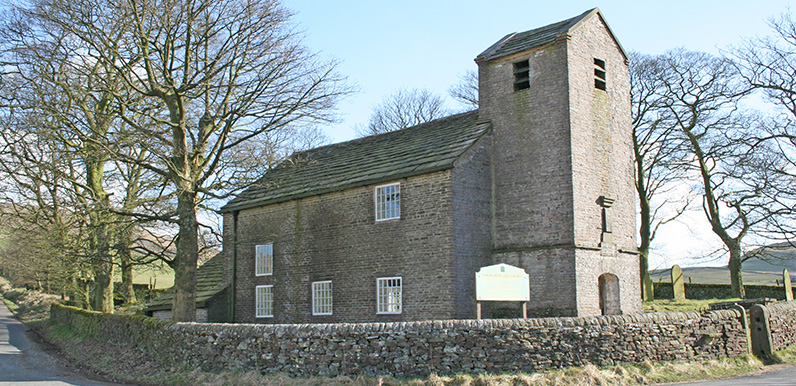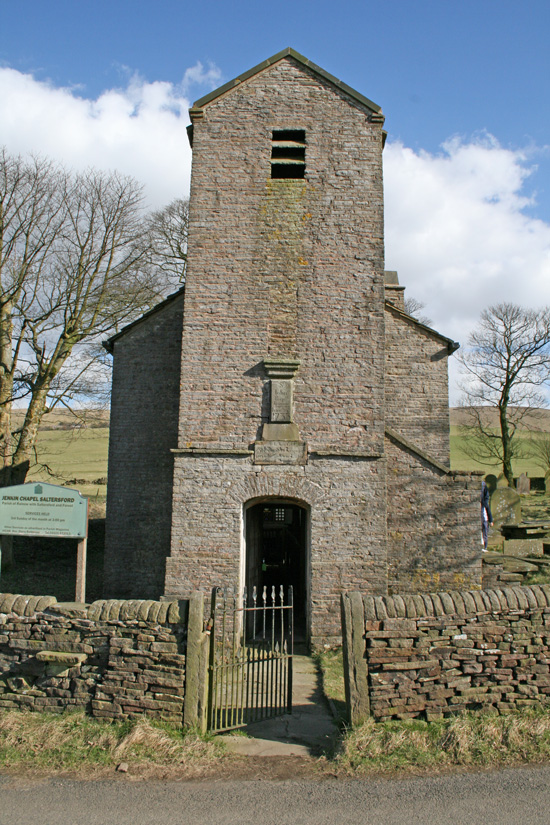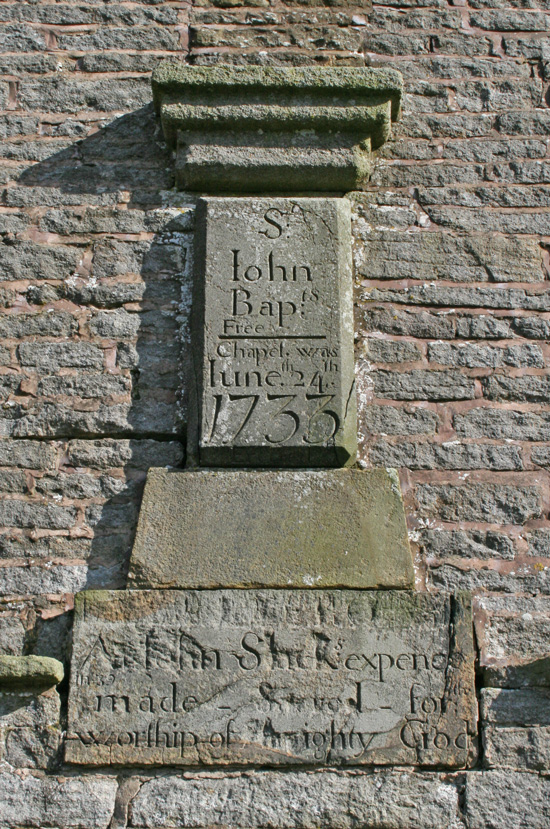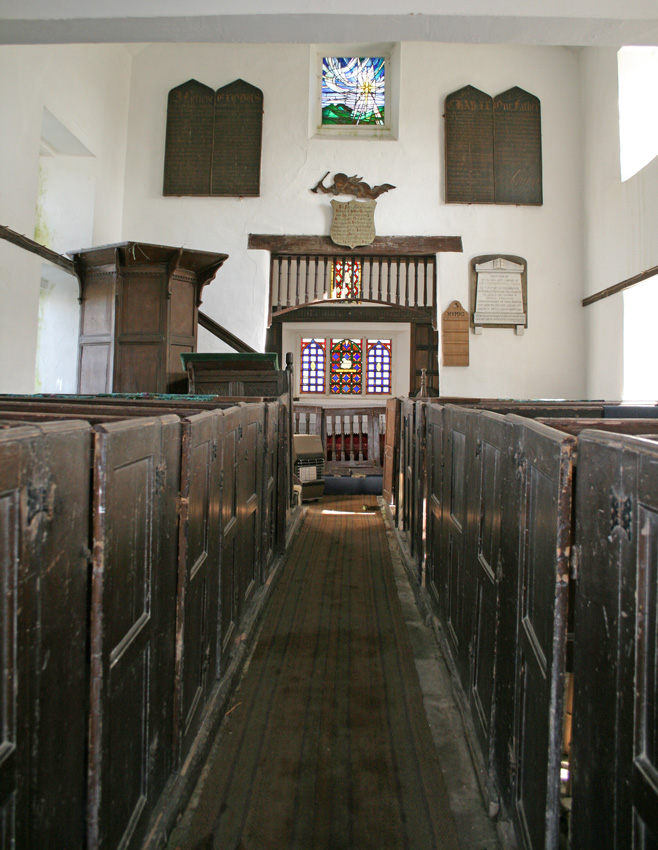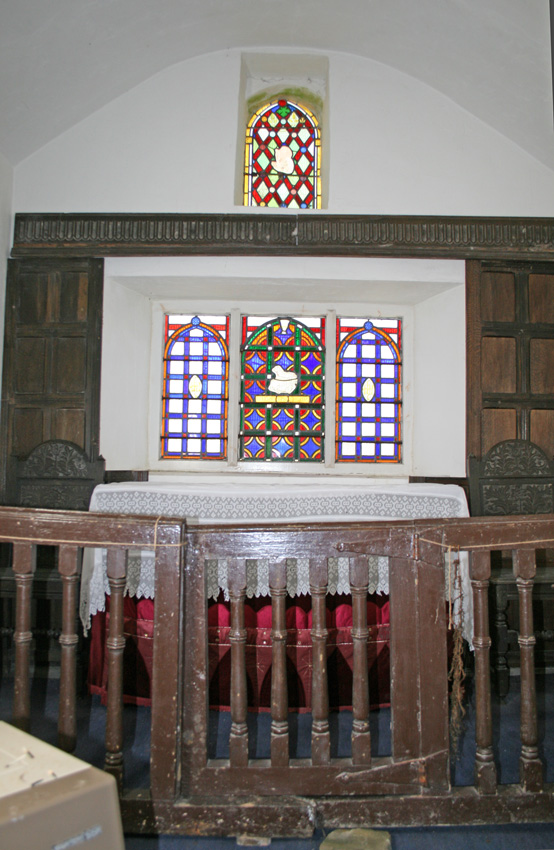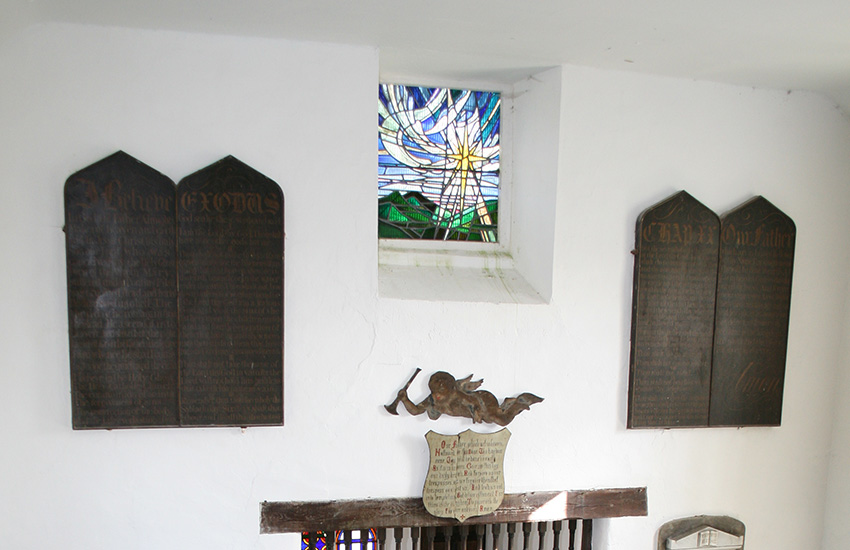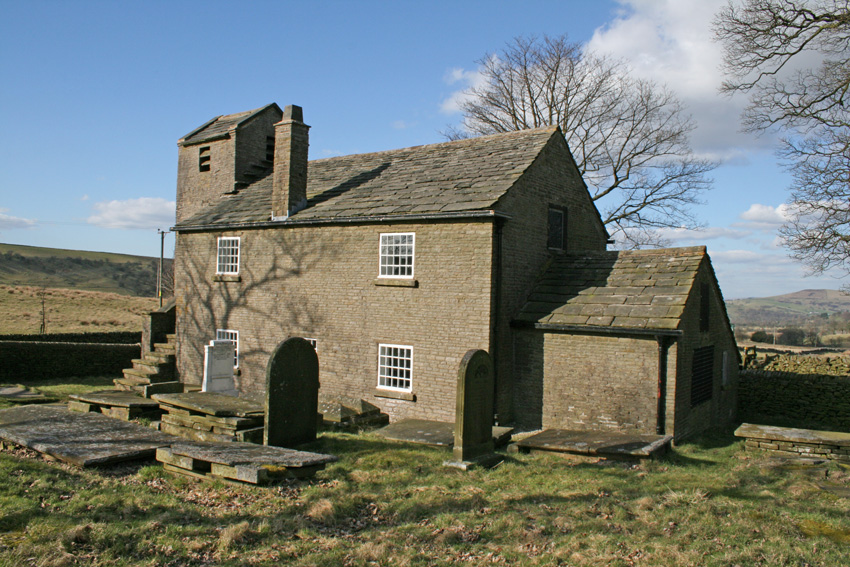Click any of the photos below to expand.
This spot has considerable historical significance, lying at the meeting point of three ancient trackways. The chapel has suffered from vandalism in the past, so is kept firmly locked. But I managed to track down a very kind lady with the keys who allowed me to take a look inside and take the photos on this page.
She also gave me permission to reproduce the guide book which explains the chapel’s history. I don’t know who the author is, but it was first published in 1977.
![]()
JENKIN CHAPEL
THE CHURCH OF ST JOHN THE BAPTIST SALTERSFORD
The Parish of Saltersford, once part of the ancient Parish of Prestbury, lies just inside Cheshire, near the border with Derbyshire. It is an upland area with a thinly scattered population of hill farmers. In 1733, these farmers, with their own labour, materials, and money, built a small chapel, which today is commonly known as Jenkin Chapel.
They built in the only style they knew, and the result was the simple cottage-type building, whose tower was added twenty one years later. The walls are of local stone with a heavy slab roof, and a rare feature is the chimney-stack. The nave has two rows of Georgian cottage windows on each side, and inside are the original box pews, high, octagonal pulpit and carved reading desk.
The chancel arch is formed by delicate, turned balusters hanging from a dark oak lintel. Above the arch is a modern stained glass window, placed there after vandals had destroyed the original in July 1974.
The small chancel has dark panelling on the east wall, and among the richly coloured glass of the east windows can be seen the figures of a child, a lamb and a chalice. In the centre of the ceiling is a decorative plaster rosette, one of the few later additions to the furnishings of the church. The altar was made from the wood of an old chest, which had belonged to the Slack family. There is a small font, made from grey stone on a tall, round shaft, with an oak cover.
There are three grave slabs forming the chancel floor, and one in the nave; all are of the Turner family, from Saltersford Hall. One reads “Here lieth the body of Richard Turner of Saltersford Hall who died Feb. 15th 1748-9 Aged 60 years. He was the first corpse that was buried at this Chapel. Also Mary, his wife who died November 5th 1796 aged 92 years.”
Richard Turner was one of the original three trustees of the chapel and the father of John Turner, who was lost in a snowstorm in 1735, while leading a team of pack-ponies. A stone marks the spot in Ewrin Lane where he was found (click to view).
There is a small gallery at the west end of the chapel, on the front of which hangs the coat of arms of the Stopford family, which had lived at Saltersford Hall in the seventeenth century, and remained chief landowners in the valley until 1947.
The tower at the west end of the chapel was built in 1754 and 1755. There is a porch with stone benches each side, and above is the bell chamber, which is reached by an outside flight of stone steps, and is lit by four small windows with stone louvres. On the wall of the tower, above the porch are two dedication stones, whose inscriptions have long been a subject of contention and discussion.
The upper stone reads “St John Bapts Free Chapel was June 24th 1733 erected” and the lower one” At John Slacks expense in (17)39 (it was) made sacred for the worship of Almighty God”.
Many people have taken the inscription to mean that the chapel was erected at John Slack’s sole expense, and someone long ago obviously felt strongly enough about this mistake to deface the lower stone. The inscriptions on the two stones shouId be read separately, thus making the real meaning clear.
Jenkin Chapel stands within a small church yard (above), surrounded by a belt of trees, which form a landmark on the bare hillside. In the yard are many old graves, some un-marked, and a few modern ones.
They record the names of the families who lived in Saltersford when the church was built:- Lomas, Latham, Turner, Potts, Kirk, Ridge and Lowe, many of which still live in the area. Of the early families, the Lomases and the Hills are represented in the present-day congregation. Other families came later:- Etchells, Ward, Wainwright, Dale, Heathcote and others.
Many of the early graves are un-marked, only a slight mound in the grass shows their presence. The earliest stones belong to the Lomas family and are near the chancel. The first is that of Edward Lomas of Saltersford, who died in 1768, and Elizabeth, his wife, who died in 1803.
The second is that of Anne, wife of Lawrence Lomas of Harrop, who died in 1771, and Lawrence himself, buried in 1772. Next to this is one stone marking the graves of Oiler Lomas, aged 15 years, Henry aged 10 years, Sarah aged 15, and Peter Lomas who died in 1884 aged 71 years.
Another tombstone, that of the Wainwrights, shows that four children died in infancy or youth, and the last child died in 1887, aged 81 years. It seems that in early days a child born in Saltersford had to be tough to survive, and if he were tough he lived to a remarkably good age – for those times.
Certainly, many of the people buried at Jenkin Chapel were very young or very old. One tombstone has the single word “Here” inscribed on it. Is the grave empty, or could the family not afford the full inscription?
The stone above the grave of Ann, wife of George Sherd, who died in 1804, George himself, buried in 1813, and Mary, his second wife has this verse on it:- Millions of transgressors poor God has for Jesus sake forgiven, Made them of His favour sure and snatched from Hell to Heaven.
THE CROSS ROADS
The church and church yard stand at the meeting of three roads; Pym Chair Lane, Moss Lane, which comes up from Todd Brook, and Red Moor Lane. These lanes are in fact ancient trackways, lying on the line of the old pack pony tracks or salters’ ways, and many authorities refer to Pym Chair Lane and The Street over the hill in the Goyt Valley as a Roman road.
From Roman times right through the mediaeval era salt was a precious and necessary commodity, and dealers used a network of pack horse tracks across the country. The origin of the name “Saltersford” becomes obvious when we realize that one of these ancient tracks passed through the parish.
The track system was later used by cattle drovers and sheep dealers – one of whom, Jenkin from Ruthin, is said to have traded from North Wales to Derbyshire in the early eighteenth century.
On the crossroads, from unknown time, had stood a “cross”, one of the ancient track-marking stones of the district (others were at Blue Boar Farm and Pym Chair), and this came to be known as “Jenkin Cross”, his business transactions being carried on there.
There is a story that Jenkin also preached at the cross, but, whether this is true or not, the chapel built there took his name. Several footpaths, still in use, also meet at the crossroads, linking the farms with what was obviously the most important place in the area.
This importance lasted right through the nineteenth century; a small market being held at the cross for the convenience of local farmers, who could easily drive their stock there.
There was also a small school at the crossroads, which was built directly opposite the chapel. A pile of stones covered with grass, with the privy alongside are the only remains. The school was built a few years after the chapel, and some thirty to forty children at a time received their education there.
It was finally pulled down about 1920. Some of the stones of a flagged path between the church and the school still show through the tarmac of the modern road; this must have been very necessary in the days when the road was only an earth track – and a very muddy one at times.
EARLY DOCUMENTS
There are several documents still in existence concerning the building and subsequent history of Jenkin Chapel. The earliest, dated April 13th, is a covenant by the inhabitants to pay £10p.a. to a Minister:- “We… Inhabitants within Saltersford… being highly sensible what a great loss we have sustaining for want of a lawful minister… and having builded a convenient Chappell… do hereby… covenant and promise to pay unto such person or persons as shall be duly qualified for the said office yearly and every year the sum of ten pounds of lawful money…”.
It is signed by seven of the inhabitants, an independant group of men who built their own “free chapel”, and, when it was done, found a minister for it. The minister was Charles Hadfield, who was the master of the free school in Chapel-en-Ie-Frith, and who was, incidentally, an ancestor of the present Charles Hadfield, proprietor of the old-established chemist’s shop in Macclesfield.
The men of Saltersford had chosen as the site for their chapel a piece of open ground at the crossroads. They thought that it was public land, and that they had a right to build there. They soon found that this was not so, when the local landowner,James Stopford (descendant of the family from Saltersford Hall), stepped in to claim it.
A lawsuit followed, which was settled in 1739; the indenture is still in existence. In it, James Stopford agrees to “give grant bargain and sell” for the sum of ten shillings “all that patch of land whereupon the said Edifice or Building now stands”, together with “the parcell of land set apart for a place of burial of the bodys of deceased Christians”.
The three trustees were Richard Oakes, yeoman, of Green Booth, Saltersford, Richard Turner, yeoman, of Saltersford Hall, and John Slack, yeoman, of the Dunge, Kettleshulme.
It can be assumed that it was this buying of the land which was referred to in the lower inscription on the tower, thus securing the chapel for the worship of Almighty God. It seems that John Slack may have paid the ten shillings himself, though there is no record of this, so causing all the trouble and later defacing of the stone.
The James Stopford who signed this indenture was the greatgrandson of the last Stopford to live in Saltersford. He, also a James Stopford, had joined the Parliamentary army in the 1650’s, and served in Ireland, where he stayed on to found his house and fortune. His grandson, James, became M.P. for Wexford, and his great grandson was created Baron Courtown of Wexford in 1762.
In 1796, the second Earl of Courtown was raised to the English peerage, taking the title Baron Saltersford. It is the coat of arms of this family which hangs from the gallery front in Jenkin Chapel.
The third important document we still have is the Consecration deed of July 18th, 1794. It is not known why there was a gap of sixty-one years between the building and the consecration of Jenkin Chapel, nor why the dedication was changed from St. John the Baptist to St John the Evangelist.
The document refers to the building of the chapel “for the ease and convenience of the Inhabitants, being very distant from their parish church”, to its complete furnishing with all the necessities for Divine Worship, and to the separation of the church and yard “from every common and prophane use”.
The occupiers of the pews paid two shillings each year towards the repair of the building, the churchwarden having a strict duty to collect this “Iay”, or to dispossess any reluctant payers.
Other interesting papers are the accounts for the building of the tower. The “Rearing Feast:” took place in June 1755, and the work was completed in the December. A “lay”, dated June 21st, 1754, was levied on all the holders of tenements in the valley to pay for it.
Twenty two tenants, all small farmers, paid up their lays, which totalled £7.2.0d, some extra money being collected by Edward Lomas, John Slack, Edmund Pott of Charleshead and Richard Turner.
The men worked hard at their task of building, doing sixteen hours a day in the summer at the rate of 1d an hour. All the building operations are mentioned, “casting foundations” and “building the stares”, as well as work at the stone pit. The modern topping-out ceremony isn’t as new as we think, for an item “For Ale when we reared, 2s 6d” appears on “June ye 9.” 1755.
The names of families in the valley appear once more in these accounts as the providers of labour, materials and money, – in fact less than thirty surnames occur in all the early papers.
WORSHIP OVER THE YEARS
Jenkin Chapel has been in continuous use since its building, although there were serious doubts at one time, A commission of Inquiry investigated in July 1890 on instructions from the Bishop of Chester. They found deficiencies in the running and worship of the church, which had always had a small congregation and “difficulties of locomotion”.
In the Articles of Inquiry (a questionnaire on the state of the parish) dated 1778, the incumbent states that “Service is performed one end of the day, three Sundays out of four, if not prevented by sickness or bad weather”, and about thirty communicants received the Sacrament four times a year.
There had never been a house for the minister, and although some money from the Royal Bounty had been invested in land and in the building of the turnpike road from Macclesfield to Buxton, it had always been a poor living.
The Commission of Inquiry said “We feel that it can be sustained only by taking a low standard of Ecclesiastical duties”, and at this time the fortunes of Jenkin Chapel were at a low ebb. The building too was in bad repair, and it was about then that the school was closed. The parish was merged with Kettleshume in 1864, though it continued to have its own minister, until in 1921 it became part of the parish of Rainow. Early in his century, however, improvements were made, the building was repaired, and has remained in good condition since then.
The chapel is now kept locked between services; when it was open, the sheep which crop the grass in the churchyard often found their way inside when looking for shelter, which no doubt contributed to the rural atmosphere.
JENKIN CHAPEL TODAY
Services are still held regularly, on the second and fourth Sundays of the month, between Easter and Christmas: any passers-by are very welcome.
At the Harvest Festival in September the churchyard is filled by a large congregation for an open-air Service – weather permitting. Plans are afoot for other services, for Ramblers, and for the young people who attend the motor-bike scrambles in the valley.
We hope that these will become a regular feature of the Jenkin Chapel year, and will help to keep the little church in the hills, with its very special feelings of religion, security and history, alive for many years to come; serving both the local people and those who pass by, as it did when it was built in 1733.
![]()
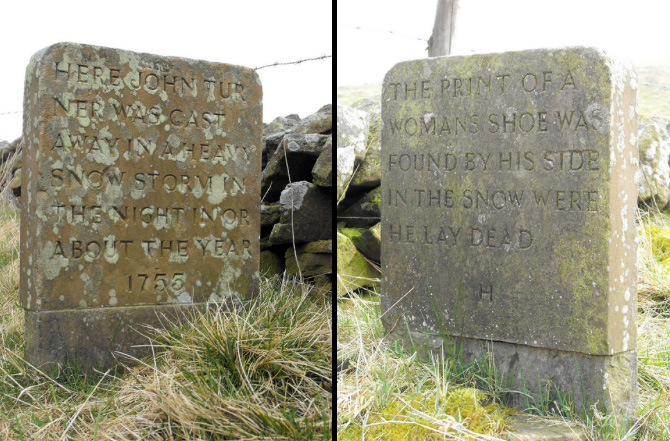
There are lots of excellent photos of the chapel – both interior and exterior – as well as other nearby places of interest on this flickr page. The photos above are taken from the page and show both sides of the intriguing ‘John Turner’ stone (click for details).
Page update: June 2020
I came across an old photo of the chapel posted on Facebook by Patrick. It’s fairly close to the one at the top of the page so I created this fade…
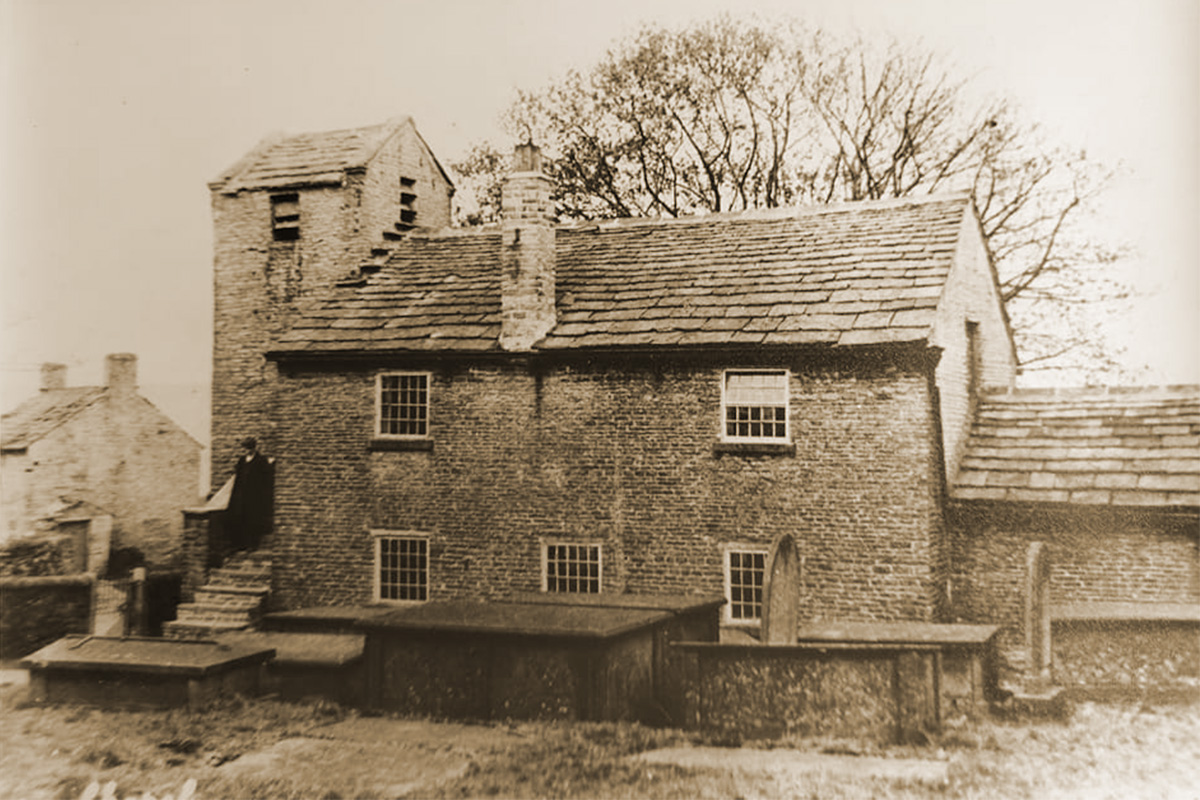
Page update: 30th May 2023
Chris on the Goyt Valley Facebook Group managed to find this photo of the chapel with someone standing on the side steps. Joe spotted it and wrote: “That’s a great picture – l have it myself. The building to the left side of church is the School, the toilet is still there. That’s my Grandfather John Hill standing on the Bell tower steps in the 1800s.”
